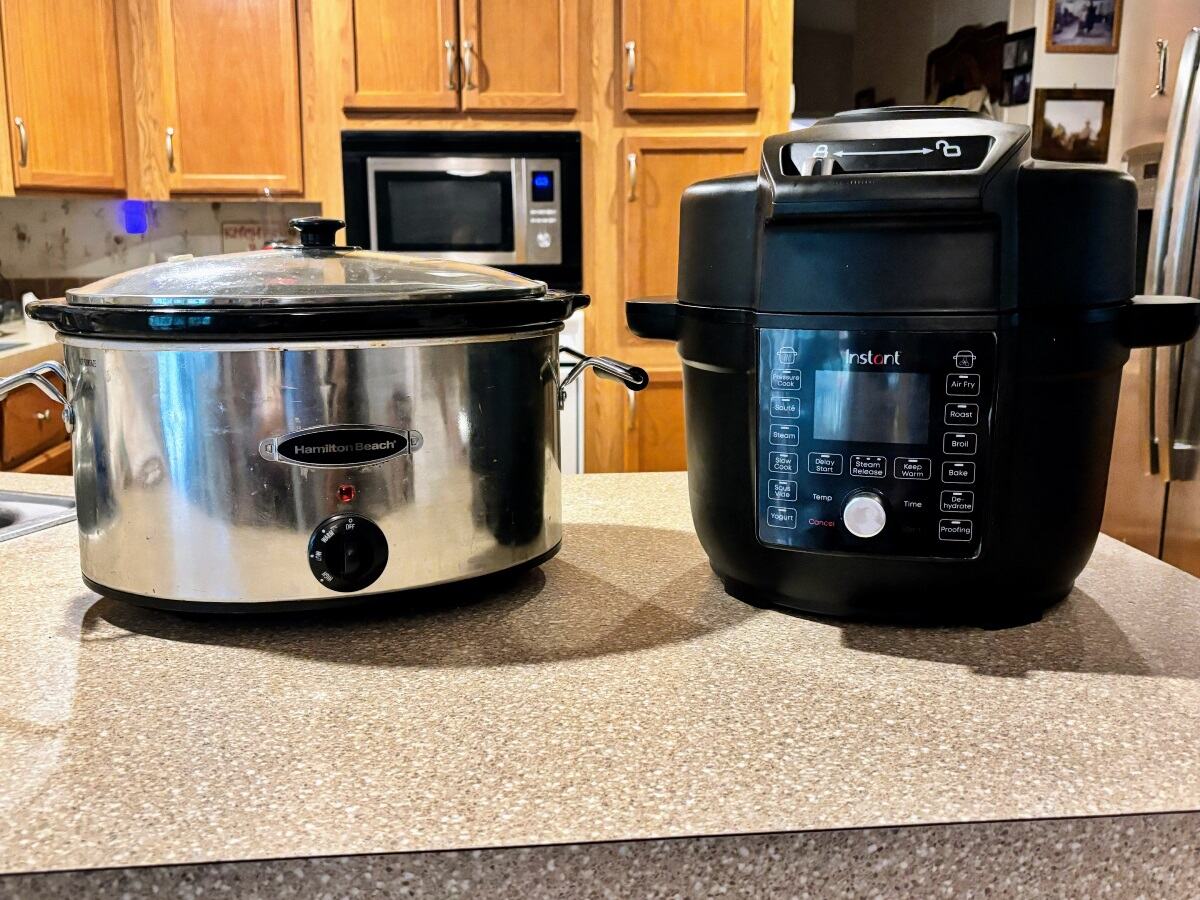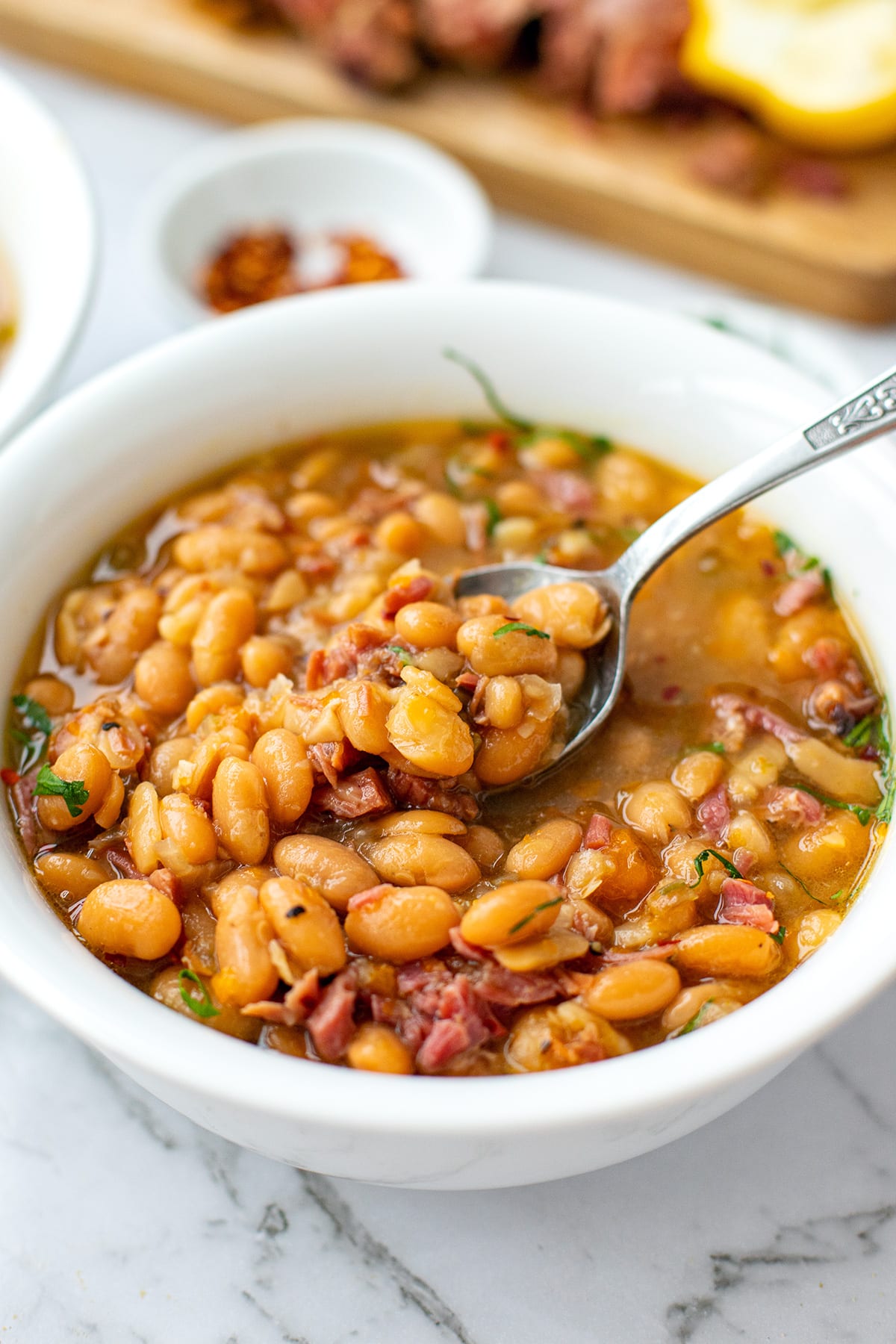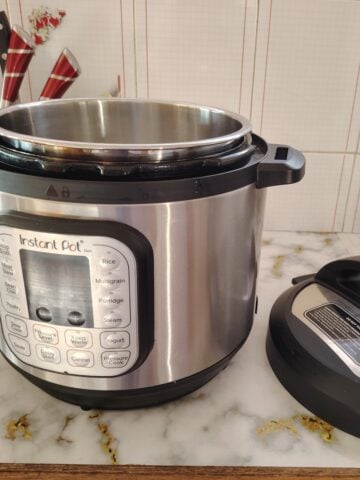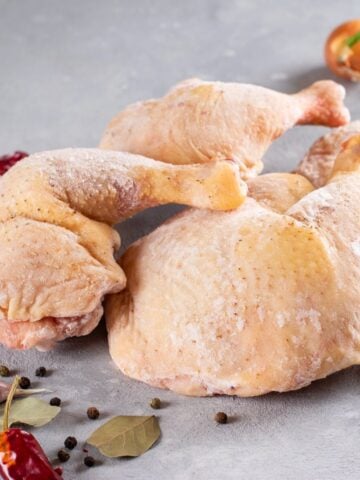
Curious about how to use your Instant Pot as slow cooker? Simply select the slow cook function to transform this versatile device into a traditional slow cooker, allowing for the gentle simmering of dishes. It’s perfect for sautéing meats to enhance their flavor before transitioning to slow cooking.
Ideal for chefs who prioritize kitchen efficiency, the Instant Pot merges multiple appliances into one, saving valuable counter space while delivering precisely cooked, flavorful meals.
I've covered these features and more throughout this post to help you make the most of your Instant Pot in slow cooker mode.
Jump to:
Understanding the Slow Cooker Function
Among many other functions, Instant Pot is also a great slow cooker. The slow cook function is a smart option for those who want the convenience of slow without using more than one appliance.
The slow cook function means you cook low and slow, like in a crock pot or other slow cooker. It is a set-it-and-forget-it style of cooking. Beans, roasts, and pork shoulders, among others, benefit greatly from a slow cooking time because it allows the food to tenderize and gain additional flavors.
The Buttons
To use your Instant Pot as a slow cooker, press the "slow cook" option. If you have a 13-in-1 Duo with the ultimate lid, insert the inner pressure lid, or the Instant Pot won't allow this function.
After you select "slow cook," you need to use the adjust button to set the temperature to less, normal, or high. The lower setting is between 180 and 190 degrees Fahrenheit, the normal is between 190 and 200 degrees Fahrenheit, and the high is between 200 and 210 degrees Fahrenheit.
To adjust the temperature, press hit/adjust or use the knob to toggle between the temperature settings. Next, use the adjust or "+/-" buttons to adjust the cooking time.
The "less" setting is the same as the "warm" setting on a traditional slow cooker and helps to thicken liquids after they are cooked. My 13-in-1 Duo Crisp has a low setting as the default setting, but the setting varies depending on the model.
Cooking Times
An Instant Pot's low and normal functions equate to the temperatures of a slow cooker. However, the high function will need a time adjustment of 15 minutes per hour of cooking time because the temperature is different between the two.
| Instant Pot Function | Slow Cooker Setting | Time Diffence |
| Low | Low | Same |
| Normal | Medium | Same |
| High | High | Add 15 minutes per hour of cooking time |
The slow cooking process in an Instant Pot is straightforward, which is what Instant Pot is designed for. Here is an overview of how to use the slow cooker function:
- Place all ingredients in the inner pot
- Press the "Slow Cook" function and adjust the temperature and cooking time.
- Seal the Instant Pot and make sure the steam vent is in the "sealing position."
- Press the start button to start cooking. Once done, the Instant Pot automatically switches the temperature to low heat.
You can always adjust the time and temperature for different textures as long as the internal temperature of the meat is correct. Some recipes may also need to be adjusted to switch from a slow cooker to an Instant Pot.
Tips for Best Results
Liquid Requirements
The Instant Pot must maintain a proper amount of liquid during cooking. The liquid produces steam and allows the cooking function to work properly.
It is also important not to overfill it with liquid. The inside of the liner has a maximum and minimum fill line, and a good rule of thumb is to always keep a minimum of one cup of liquid during the cooking process.
Overcoming Heating Issues
If the Instant Pot has difficulty reaching the proper temperature, you can always use the Saute function before slow cooking. This function brings the inner pot to a high temperature before adding liquid and other ingredients.
The saute function also benefits meat cuts, carmelizing the meat, adding flavor, and locking in the juices.
Lid Choice
If you've ever wondered why an Instant Pot lid differs from a slow cooker lid, it is because of the pressure. A standard instant pot lid is designed for the cooker to develop pressure, while the tempered glass lid on a slow cooker allows steam to escape during the cooking process.
However, when an Instant Pot is using the slow cooker function, it does not utilize pressure to cook because it is a slower method. Tempered glass lids are available for Instant Pots that allow steam to release, and it is a good idea to use one when slow cooking.
Instant Pot sells a tempered glass lid for slow cooking. The standard lid is designed to seal and lock in moisture, while the glass version allows steam to vent slowly during cooking. This is especially helpful if you are slow cooking delicate foods like fruit.
Brown Your Meat First (Optional)
This is one of my favorite Instant Pot cooking methods for making a pot roast. It utilizes the Maillard Effect, which adds the sear to the meat before it slowly cooks.
The saute function browns the meat before you add the rest of the ingredients for the slow cooking function. The beauty is that you use the same inner pot, so there are no extra dishes to wash.
For sauteeing, keep the lid off, sear each side of the meat for a couple of minutes, deglaze the bits, and then start the slow cooking process. You'll notice a more flavorful cut of meat, almost like it has been grilled, and it will become one of your favorite slow cooker recipes.
Recipe Adaptations
As a chef who works offshore, I have a lot of free time. Since I am an unabashed food nerd, I fight the boredom by creating new recipes (or at least attempting to do so) and experimenting with different kitchen appliances.
Not All Recipes Are Equal
When switching recipes from a slow cooker to an Instant Pot, the key rule is that not all recipes are created equal. Slow cooker recipes differ widely from Instant Pot recipes regarding cooking time and texture.
For instance, if a slow cooker recipe calls for something to be cooked for eight hours on low heat or four hours on high heat, the Instant Pot will cook the same food in about half an hour.
A slow cooker's heavy ceramic inner pot is designed to heat up on all sides and spread the heat evenly around the food. An Instant Pot's inner liner is thin and designed to heat quickly from the bottom to create steam and cook food under pressure for faster cooking time.
Vegetables
Vegetable dishes are one of the main dishes that cook noticeably differently in an Instant Pot than in a crock pot. Since an Instant Pot cooks under pressure, the texture of the cooked vegetables can turn out too soft or even mushy.
If cooking vegetables in an Instant Pot, it is best to steam them using an appropriate basket or on the slow cooker setting so that no pressure builds up while cooking.
If you are cooking a dish that calls for vegetables, adding them near the end of the cooking time is best to retain their flavor, nutrients, and correct texture.
Thickening
Since Instant Pots retain more moisture than a slow cooker, the dish you are cooking may need to thicken up after the food is done cooking, like a roast or soup.
Depending on the recipe, it may thicken naturally as it cools, or you may need to use a thickening agent.
A thickening agent can be corn starch, slurry, flour, or arrowroot. Chefs typically use flour as it is readily available. For thinner liquids, a slurry is your best friend.
Advantages of Using Instant Pot as a Slow Cooker

Speed
The biggest benefit of pressure cooking is the speed at which food cooks. Since I started pressure cooking dried beans, which only takes 30-40 minutes, I no longer use a crockpot.
The pressure cooker function has changed the game in the kitchen in terms of versatility and speed. No appliance beats an electric pressure cooker when preparing delicious meals in under an hour.
Versatility
The versatility of an Instant Pot is a huge bonus in terms of cooking time and functionality. Slow cookers definitely have a place in the kitchen, which is why I still have a dedicated slow cooker, but the multi-cooking functions of an Instant Pot are worth their weight in gold.
Earlier, we discussed the saute function, a smart option for additional flavor. Other features like a rice cooker, pressure cooker, and slow cooker functions allow you to make an entire meal in a single pot.
Energy Efficiency
Instant Pots are also more energy efficient than other kitchen appliances, such as traditional slow cookers, because they prepare food much quicker, even when using the slow cooker option.
When NOT to Substitute a Slow Cooker
Large Cuts of Meat
I admit I have made this mistake in the past (remember when I said I got bored offshore?) Instant Pots are great, but like all appliances, they have limitations.
Food in an Instant Pot needs to be comfortable and not overcrowded. If you have to cram a large cut of meat, like a pork shoulder, into an Instant Pot, you will be disappointed in the results.
The pork shoulder may be technically edible, but it will not cook evenly so that the outside will be undercooked in some spots, overly cooked in others, and the inside will be tough and chewy.
All-Day Cooking
Don't get me wrong—I love my Instant Pot and look for excuses to use it as much as possible. But something is reassuring about cooking food for ten hours or more.
A traditional slow cooker excels at cooking for an extended period. After all, that was what they were designed to do. Slow cooking for long periods produces flavor-infused, tender food every time. Plus, it makes your kitchen smell heavenly.
Even if you use your Instant Pot for slow cooking, the food will still be ready in less than one hour. The term slow in this context refers to the Instant Pot, not slow cookers.
At the end of the day, choosing between an Instant Pot and a slow cooker for slow cooking boils down to time, the size of the food, and personal preference. While an instant pot is great for slow cooking, don't be afraid to occasionally show your slow cooker some love.
Wrapping It Up in the Pot
The main difference between an Instant Pot and a traditional slow cooker is cooking time. While slow cookers take four to eight hours to cook, an Instant Pot does the same in under an hour, thanks to its efficient slow cook button.
This is not to say that an Instant Pot is better—it just serves a different purpose. The slow cooker function produces the same texture as a slow cooker in faster times, but it has limitations like texture or capacity restrictions.
It is best to have a dedicated slow cooker and, if possible, your Instant Pot on hand. Sometimes, slow-cooking food for longer periods is just comforting, while other times, having comfort food in less than an hour is deliciously satisfying.
For more tips or if you want to try an easy instant pot recipe, check out our collection on the site!










Leave a Reply